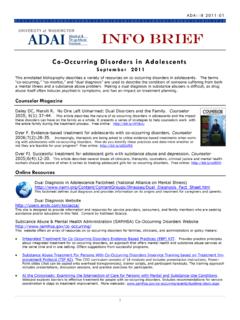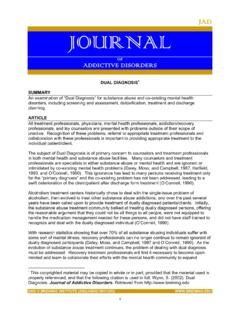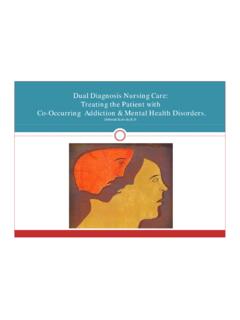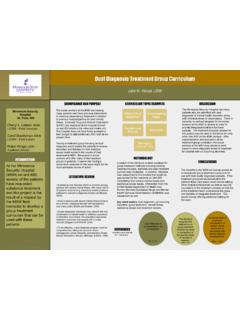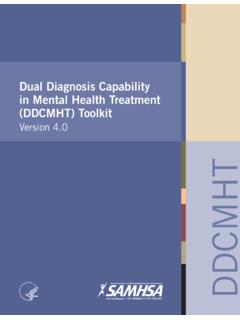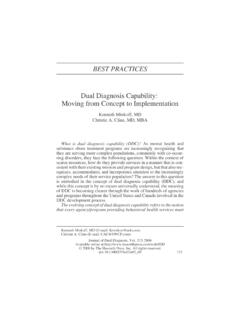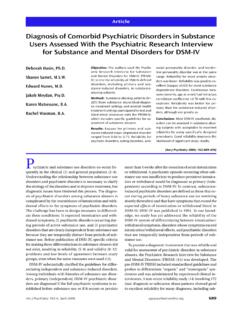Transcription of Diag Diagnosisnosis Diagnosis - Healthy Transitions
1 A Guidebook for Scharoun, is the author of this guidebook. She is the current Chairperson of the Department of Psychology at LeMoyne College where she teaches undergraduate courses in Brain and Behavior, The Psychology of Disabilities, Motivation and Emotion, Human Lifespan Development and Disorders of Childhood. Dr. Scharoun is also a Psychologist with the New York State Office for People with Developmental Disabilities. She has over twenty years of experience working with children and adults who have developmental disabilities in residential, vocational, academic and home settings. She is also a sibling of a person with a developmental disability. 1 Dear Caregivers, I am a psychologist who helps people who have dual Diagnosis . This term is used when a person with a developmental disability also has a mental illness. It is often hard to diagnose a mental illness in a person who has a developmental disability. However, in order to provide effective treatment, it is very important to differentiate symptoms of a mental disorder from behaviors associated with the developmental disability.
2 Many people who have a developmental disability have a difficult time conveying accurate information at the time of assessment. Parents, siblings, or even direct support staff and other service providers can be valuable resources in defining the symptoms and identifying behaviors of concern. This guidebook gives caregivers the tools they need to understand how mental illness might look in a person with a developmental disability, and information on what to do and where to go for help. It was written in order to help caregivers to partner with health care providers. The goal is high quality medical and psychiatric care for people with developmental disabilities. This guidebook is organized into five sections that answer questions that caregivers often ask me: What is dual Diagnosis ? .. page 2 Why is it so hard to make this Diagnosis ? .. page 4hoW is a dual Diagnosis established? .. page 13 Who can help? .. page 24 Where can I go to learn more? .. page 27 This guidebook was written in 2011 for the New York State Institute for Health Transition Training with grant support from the New York State Developmental Disabilities Planning Council.
3 The section "How is a dual Diagnosis established?" was written by Nienke P. Dosa MD, MPH. Kathy Ahern RN, Nienke Dosa MD, MPH, Laurie James MEd, Wendy Leonard MS, LMHC, Gregory Liptak MD, MPH, and Pat Slaski MEd reviewed drafts for this guidebook and helped to develop the reference charts. Holly Scherzi designed the diagrams and tables. Continuing education credits are available for health care professionals who review this guidebook. Please visit for more information: I hope that this guidebook will be helpful to people with developmental disabilities and their families. For more information about this project, and to contact us, please visit Sincerely, Susan Scharoun PhDAssociate Professor of PsychologyLeMoyne CollegeSyracuse, New YorkDual Diagnosis The term dual Diagnosis refers to the presence of a mental illness or mental disorder among individuals with a developmental disability. The most common developmental disability is intellectual disability (mental retardation), but individuals with autism, cerebral palsy and neurological impairment can also have a mental illness and be considered dually diagnosed.
4 dual Diagnosis is a term that can also be used to describe the co-existence of a mental illness and substance abuse. People with intellectual disabilities can also have substance abuse problems. However in this guide, dual Diagnosis refers to the co- Diagnosis of a psychiatric condition in a person who has a developmental disability. In New York State Developmental Disability is defined in Subdivision 22 of section of the Mental Hygiene Law. The most recent amendment of this law was enacted on July 31, 2002. The law states:Developmental disability means a disability of a person which:A. (1) is attributable to mental retardation, cerebral palsy, epilepsy, neurological impairment, familial dysautonomia or autism; (2) is attributable to any other condition of a person found to be closely related to mental retardation because such condition results in similar impairment of general intellectual functioning or adaptive behavior to that of mentally retarded persons or requires treatment and services similar to those required for such person; or (3) is attributable to dyslexia resulting from a disability described in subparagraph (1) or (2) of this paragraph;B.
5 Originates before such person attains age twenty-two;C. has continued or can be expected to continue indefinitely; andD. constitutes a substantial handicap to such person s ability to function normally in society. It is important to understand the legal definition of developmental disability, because this definition is used to determine whether a person qualifies for services. However, the practical definition is a childhood onset condition that affects day to day functioning, as reflected by IQ scores that are more than 2 standard deviations below the mean (IQ less than 70) as well as a formal evaluation of adaptive functioning that documents daily living skills that are more than two standard deviations below the mean (less than 70). A mental disorder or mental illness is a psychological or behavioral pattern that causes distress or disability that is not expected as part of normal development or culture. Research suggests that mental illnesses are the result of WHATWhat isDual Diagnosis ?
6 This section lists medical and legal definitions that are used in new york state to define developmental disability, intellectual disability, and mental health disorders. dual Diagnosis a complex interaction of genetic, biological, personal and environmental factors. The brain, often referred to as the final common pathway for the control of behavior, cognition, mood and anxiety, is the primary organ system involved with mental illnesses. The links between specific brain dysfunction and various mental illnesses are not fully understood. Mental illness can be brought on by stressful life events. However it is important to note that mental illnesses are not the result of personal weakness, lack of character or poor upbringing. The recognition and understanding of mental disorders have changed over time and across cultures. The National Association on Mental Illness (NAMI ) defines mental illnesses as medical conditions that disrupt a person s thinking, feeling, mood, ability to relate to others and daily functioning.
7 Just as diabetes is a disorder of the pancreas, mental illnesses are medical conditions affecting brain function that result in a diminished capacity for coping with the ordinary demands of recently, it was believed that people with developmental disabilities could not also have a mental illness. It is now recognized that persons who have developmental disabilities are at increased risk for mental illnesses, or psychiatric disorders. The exact prevalence of mental illness among persons with developmental disabilities is not known, but some experts in the field believe that it could be 4-5 times more prevalent than in the general population. (Rush, et. al., 2004). Thus, dual Diagnosis is common. Unfortunately studies have shown that people with developmental disabilities often have difficulty accessing psychiatric care and mental health services. Quality of care is a concern as well. In a recent study adults with developmental disabilities were seven times more likely to report inadequate emotional support, compared with adults who do not have disabilities.
8 (Havercamp, et al., 2004). This guidebook was written in order to improve the access to care and the quality of care that is provided to people who have a dual this guide, dual Diagnosis refers to the co- Diagnosis of a psychiatric condition in a person who has a developmental disability. dual Diagnosis Why is it so hard to properly Diagnosis a mental illness in a person with an intellectual or developmental disability? A phenomenon referred to as diagnostic overshadowing is part of the problem (Reiss & Szysko, 1983). The term diagnostic overshadowing refers to the tendency clinicians have to attribute all the behavioral and emotional problems to the developmental disability instead of the mental illness. Because of this, many psychologists, social workers and psychiatrists miss anxiety, depression, and even psychotic symptoms. They believe the symptoms are due to intellectual or developmental disability instead of mental illness. The intellectual or developmental disability overshadows the other problem is that many professionals in the field of mental illness simply do not have training or experience in the field of intellectual disability and developmental disabilities and therefore erroneously attribute psychiatric problems to the other condition.
9 An excellent resource was recently published to help professionals to accurately diagnose psychiatric conditions in people with developmental disabilities. The Diagnostic Manual Intellectual Disability: A Textbook of Diagnosis of Mental Disorders in Persons with Intellectual Disability (DM-ID) is a guide for diagnosing mental illness in people who have intellectual disability. More information about the DM-ID is available at , the website of NADD, an association for persons who have a developmental disability and mental health , assessments, and classifications of mental disorders can vary. For the sake of consistency, in this guidebook we will use criteria identified in the Diagnostic and Statistical Manual of Mental Disorders, Fourth Edition (DSM-IV-TR) and the Diagnostic Manual Intellectual Disability: A Textbook of Diagnosis of Mental Disorders in Persons with Intellectual Disability (DM-ID). The Diagnostic and Statistical Manual of Mental Disorders, (DSM-IV-TR) is a manual published by the American Psychiatric Association that is used by clinicians in the field of medicine and psychology to properly diagnose people with mental illnesses.
10 As noted previously, the Diagnostic Manual Intellectual Disability: A Textbook of Diagnosis of Mental Disorders in Persons with Intellectual Disability (DM-ID) is a recently published guide for diagnosing mental illness in people who have intellectual disability. The four major categories for mental health disorders are Attention Disorders, Anxiety Disorders, Mood Disorders, and Thought Disorders. The following sections provide general information about each of these categories, followed by diagnostic and treatment considerations relevant to dual Diagnosis in patients who have an intellectual disability or a developmental Is It so hard to Make this Diagnosis ?In this section I talk about diagnostic overshadowing and give information about a very important reference for professionals called theDiagnostic Manual Intellectual Disability: a textbook of Diagnosis of Mental Disorders in Persons with Intellectual Disability (DM-ID). Descriptions of all the common mental illnesses that are referenced in the DM-ID are Diagnosis attentIon DIsorDersThe core characteristics of Attention Deficit and Hyperactivity Disorders (ADHD) are inattention, hyperactivity and People who display the symptom of inattention find it challenging to focus on one task or to follow through on requests or instructions.
